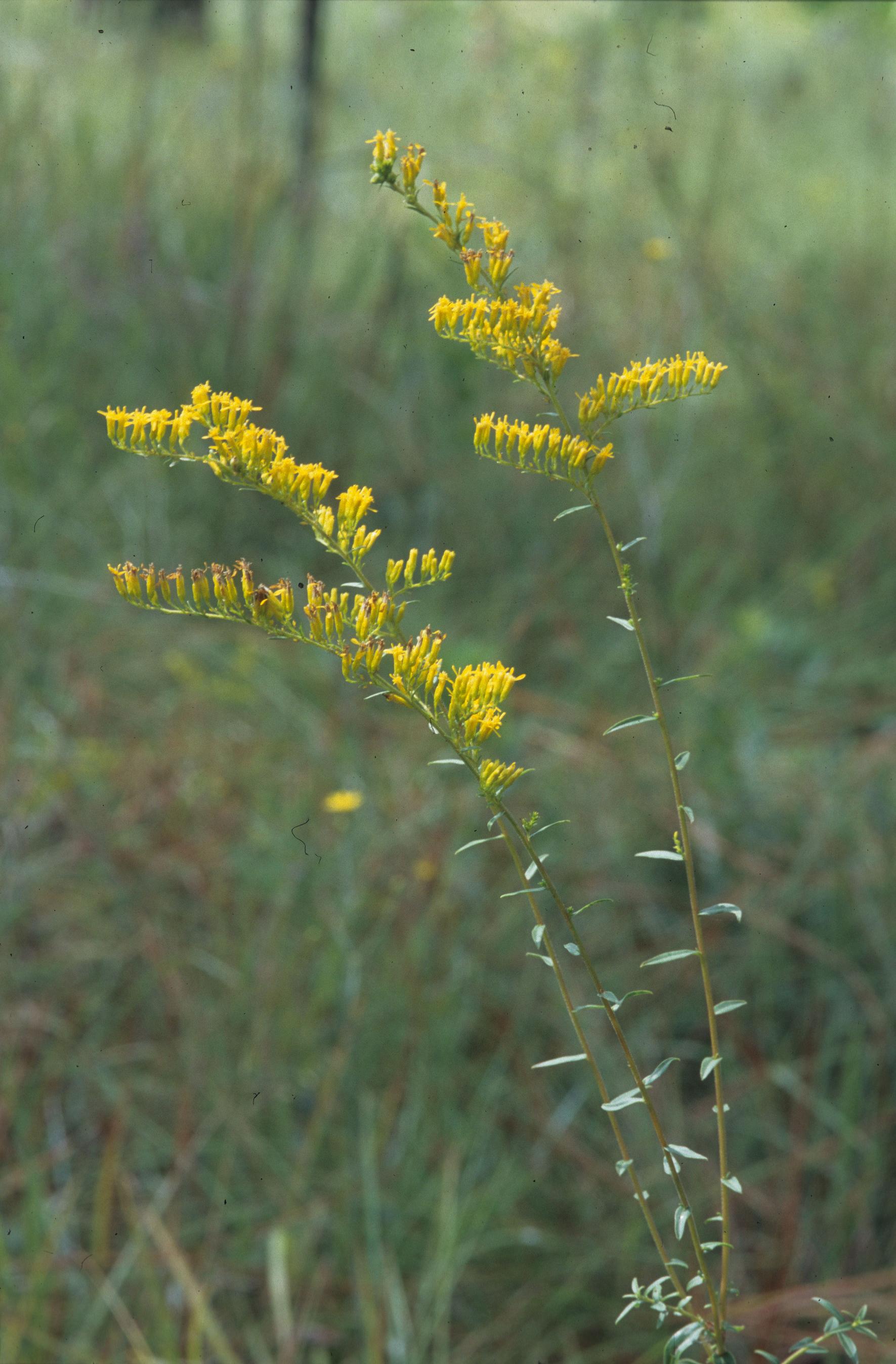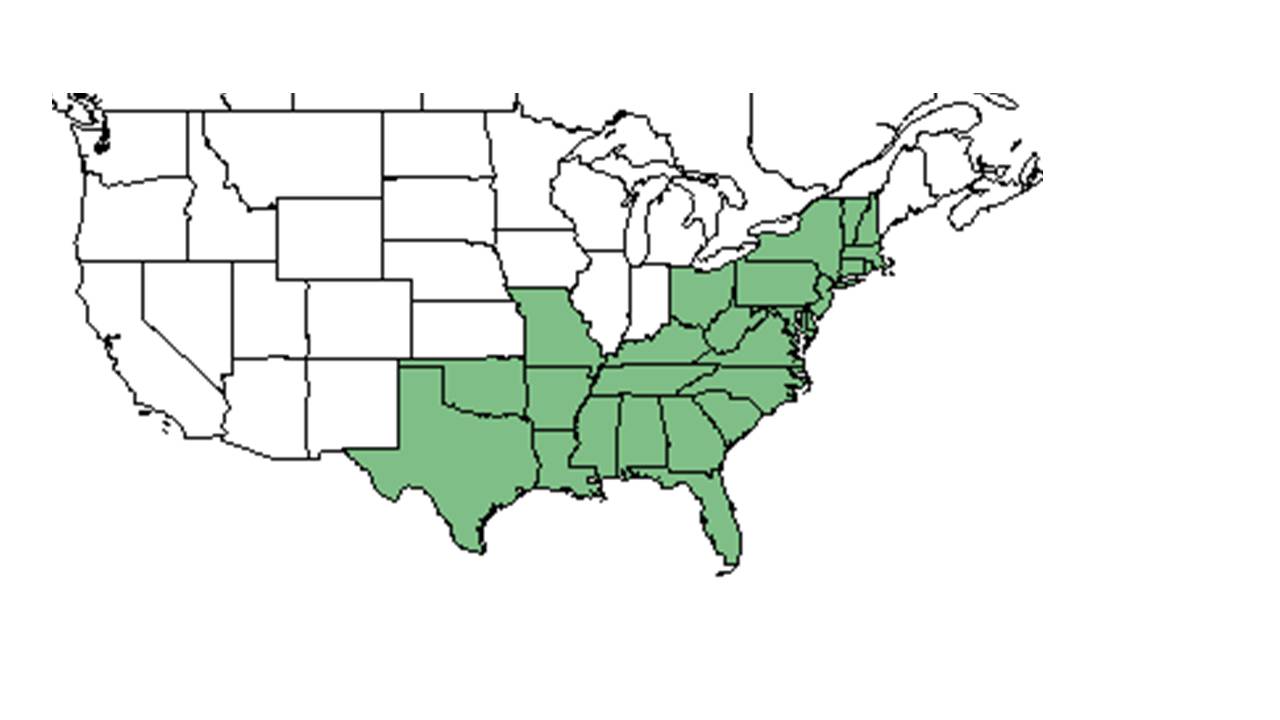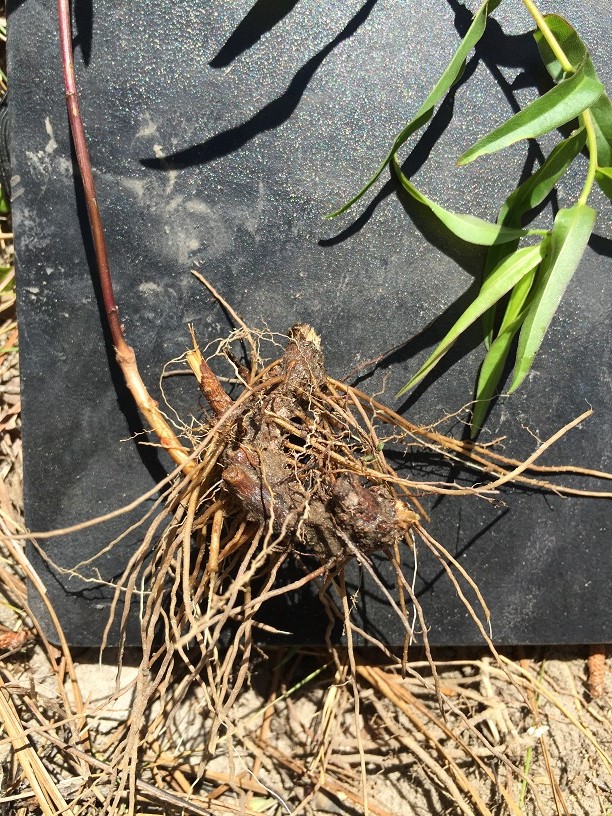Solidago odora
| Solidago odora | |
|---|---|

| |
| Photo was taken by Gil Nelson | |
| Scientific classification | |
| Kingdom: | Plantae |
| Division: | Magnoliophyta – Flowering plants |
| Class: | Magnoliopsida – Dicotyledons |
| Order: | Asterales |
| Family: | Asteraceae ⁄ Compositae |
| Genus: | Solidago |
| Species: | S. odora |
| Binomial name | |
| Solidago odora Aiton | |

| |
| Natural range of Solidago odora from USDA NRCS Plants Database. | |
Common name: anisescented goldenrod
Contents
Taxonomic notes
Synonyms: Solidago odora var. odora; S. odora ssp. odora
Description
A description of Solidago odora is provided in The Flora of North America.
Distribution
Ecology
Habitat
In the Coastal Plain region, S. odora can be found in sandhills, slashpine savannas, longleaf pine-scrub oak ridges, loblolly pine-sweetgum stands, longleaf pine-wiregrass sand ridges, depression marshes, edges of wetlands, sand dunes, live oak woodlands [1], annually burned pinelands. [2] [3] [1] xeric areas [4], longleaf pine savannas [5] [1], and scrub communities. [1] [6] It can also be found in cut over fields, disturbed savannas, bulldozed pines, old fields, cut and slashed slash pine forests, vacant beach lots, cut over sandridges [1], and roadsides. [2] [1] Soils include sandy loam, loamy sand, sandy clay, red sandy clay, and sandy peat.[5] [1] Associated species include Liatris, Panicum, Leptoloma cognata, Pityopsis graminifolia, Quercus minima, Q. laevis, Phyla nodiflora, Solidago puberula, Asclepias, Scutellaria floridana, Balduina, and Sporobolus [1]
Phenology
S. odora flowers April through November and fruits June through November. [1]S. odora var. chapmanii often blooms in late summer and fall (July through October), though some bloom in spring. [6]
Seed dispersal
Seeds are dispersed by wind. [2] According to Kay Kirkman, a plant ecologist, this species disperses by wind. [7]
Seed bank and germination
S. odora var. chapmanii does not seem to form a large persistent seed bank. [6] However, S. odora had a 12% germination rate in an experiment by Coffey and Kirkman and in the second year after burial, S. oodora showed that the seed bank can persist at least two years. [8] Between fires, S. odora var. chapmanii can persist as suppressed ramets (a persistent bud bank), which can give it an advantage over competitors. [6]
Fire ecology
It thrives in the years post-fire. [4] Lewis and Harshbarger found out that S. odora responded positively to a wide variety of long-term burning treatments, which responded the best to periodic summer and biennial summer burnings. [9]S. odora was not present in the unburned control plot. [9] After fire, S. odora var. chapmanii can regenerate by seedlings, clonal ramets, or resprouting. [6] It is thought that timing of fires may affect subsequent flowering. Flowering occurred abundantly in most plots during the year following fire, but experienced a marked decline afterwards. [6]
Pollination
The following Hymenoptera families and species were observed visiting flowers of Solidago odora at Archbold Biological Station. [10]
Apidae: Apis mellifera, Bombus impatiens, Nomada fervida, Xylocopa virginica krombeini
Colletidae: Colletes mandibularis
Halictidae: Agapostemon splendens, Augochlorella aurata, Augochloropsis metallica, A. sumptuosa, Halictus poeyi, Lasioglossum coreopsis, L. nymphalis, L. placidensis, Sphecodes heraclei
Leucospidae: Leucospis slossonae, L. affinis, L. robertsoni, L. slossonae
Megachilidae: Anthidiellum perplexus, Coelioxys sayi, Dianthidium floridiense, Dolichostelis louisiae, Megachile albitarsis, M. mendica, M. texana
Pompilidae: Anoplius atrox, Paracyphonyx funereus
Sphecidae: Ammophila urnaria, Bembix sayi, Bicyrtes capnoptera, B. quadrifasciata, Cerceris blakei, C. flavofasciata floridensis, C. fumipennis, Ectemnius decemmaculatus tequesta, Isodontia auripes, I. exornata, Oxybelus decorosum, Palmodes dimidiatus, Philanthus ventilabris, Prionyx thomae, Stictiella serrata, Tachytes grisselli, T. guatemalensis, T. pepticus, T. validus
Vespidae: Eumenes fraternus, E. smithii, Euodynerus boscii boharti, E. megaera, Pachodinerus erynnis, Pachodynerus erynnis, Parancistrocerus salcularis rufulus, Pseudodynerus quadrisectus, Stenodynerus fundatiformis, S. histrionalis rufustus, S. lineatifrons, S. oculeus, S. pulvinatus surrufus, Zethus spinipes
Use by animals
Many herbivores, including certain species of beetles, moths, rodents, and rabbits, feed on S. odora var. chapmanii. [6] Deyrup observed these bees, Colletes mandibularis, Perdita graenicheri, Agapostemon splendens, Augochlorella aurata, Augochloropsis metallica, A. sumptuosa, Diialictus coreopsis, D. nymphalis, D. placidensis, Halictus ligatus, Sphecodes heraclei, Dianthidium floridiense, Megachile albitarsis, M. mendica, M. texana, Apis mellifera, on Solidago odora var. chapmanii. [11]
Conservation and Management
Cultivation and restoration
Photo Gallery
References and notes
- ↑ 1.0 1.1 1.2 1.3 1.4 1.5 1.6 1.7 1.8 Florida State University Robert K. Godfrey Herbarium database. URL: http://herbarium.bio.fsu.edu. Last accessed: July 2015. Collectors: Travis MacClendon, Karen MacClendon, B. Boothe, M. Boothe, Bian Tan, Brenda Herring, Jame Amoroso, Loran C. Anderson, Gwynn W. Ramsey, R.K. Godfrey, R. S. Mitchell, Paul L. Redfearn, Jr., Angus Gholson, George R. Cooley, Richard J. Eaton, James D. Ray, Jr., R L Lazor, V. I. Sullivan, A. F. Clewell, R. Kral, H. E. Grelen, Gary R. Knight, R. A. Norris, R. Komarek, Cecil R Slaughter, S. W. Leonard, R. E. Perdue, Jr., Richard D. Houk, James D. Ray, Jr., Olga Lakela, Jackie Patman, Melanie R. Darst. States and Counties: Florida: Alachua, Calhoun, Clay, Columbia, Dixie, Escambia, Franklin, Gadsden, Gulf, Hernando, Highland, Hillsborough, Jackson, Jefferson, Leon, Liberty, Marion, Martin, Okaloosa, Osceola, Pasco, Pinellas, Polk, Santa Roasa, Seminole, St. Johns, St. Lucie, Suwannee, Taylor, Wakulla, Walton, Washington. Georgia: Camden, Grady, Thomas. Compiled by Tall Timbers Research Station and Land Conservancy.
- ↑ 2.0 2.1 2.2 Boerner, R. E. J. (1981). "Forest structure dynamics following wildfire and prescribed burning in the New Jersey pine barrens." American Midland Naturalist 105: 321-333.
- ↑ Brewer, J. S. and S. P. Cralle (2003). "Phosphorus addition reduces invasion of a longleaf pine savanna (southeastern USA) by a non-indigenous grass (Imperata cylindrica)." Plant Ecology 167: 237-245.
- ↑ 4.0 4.1 Harrod, J. C., M. E. Harmon, et al. (2000). "Post-fire succession and 20th century reduction in fire frequency on xeric southern Appalachian sites." Journal of Vegetation Science 11: 465-472.
- ↑ 5.0 5.1 Drewa, P. B., J. M. Thaxton, et al. (2006). "Responses of root-crown bearing shrubs to differences in fire regimes in Pinus palustris (Longleaf pine) savannas: exploring old-growth questions in second-growth systems." Applied Vegetation Science 9: 27-36.
- ↑ 6.0 6.1 6.2 6.3 6.4 6.5 6.6 Menges, E. S. and R. B. Root (2004). "The life of a fire-adapted Florida goldenrod, Solidago odora var. chapmanii." American Midland Naturalist 151: 65-78.
- ↑ Kay Kirkman, unpublished data, 2015.
- ↑ Coffey, K. L. and L. K. Kirkman (2006). "Seed germination strategies of species with restoration potential in a fire-maintained pine savanna." Natural Areas Journal 26: 289-299.
- ↑ 9.0 9.1 Lewis, C. E. and T. J. Harshbarger (1976). "Shrub and herbaceous vegetation after 20 years of prescribed burning in the South Carolina coastal plain." Journal of Range Management 29: 13-18.
- ↑ Deyrup, M.A. and N.D. 2015. Database of observations of Hymenoptera visitations to flowers of plants on Archbold Biological Station, Florida, USA.
- ↑ Deyrup, M. and L. Deyrup (2012). "The diversity of insects visiting flowers of saw palmetto (Arecaceae)." Florida Entomologist 95(3): 711-730.
